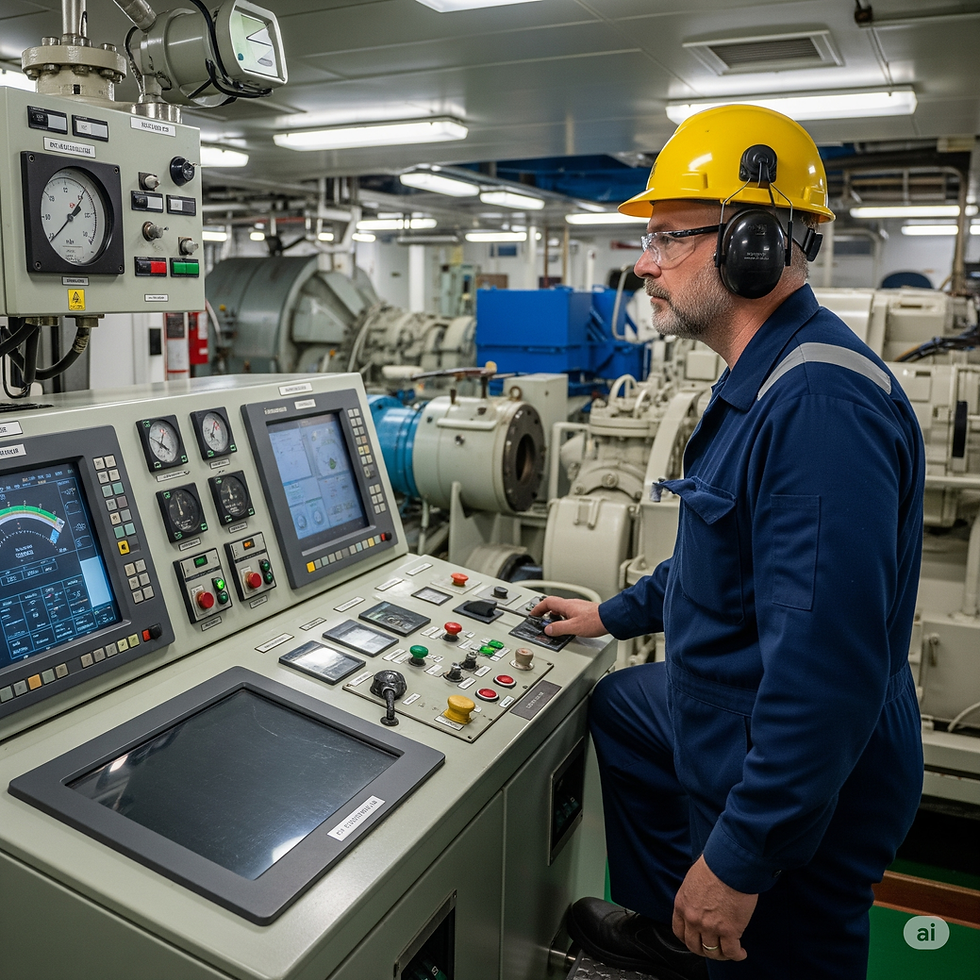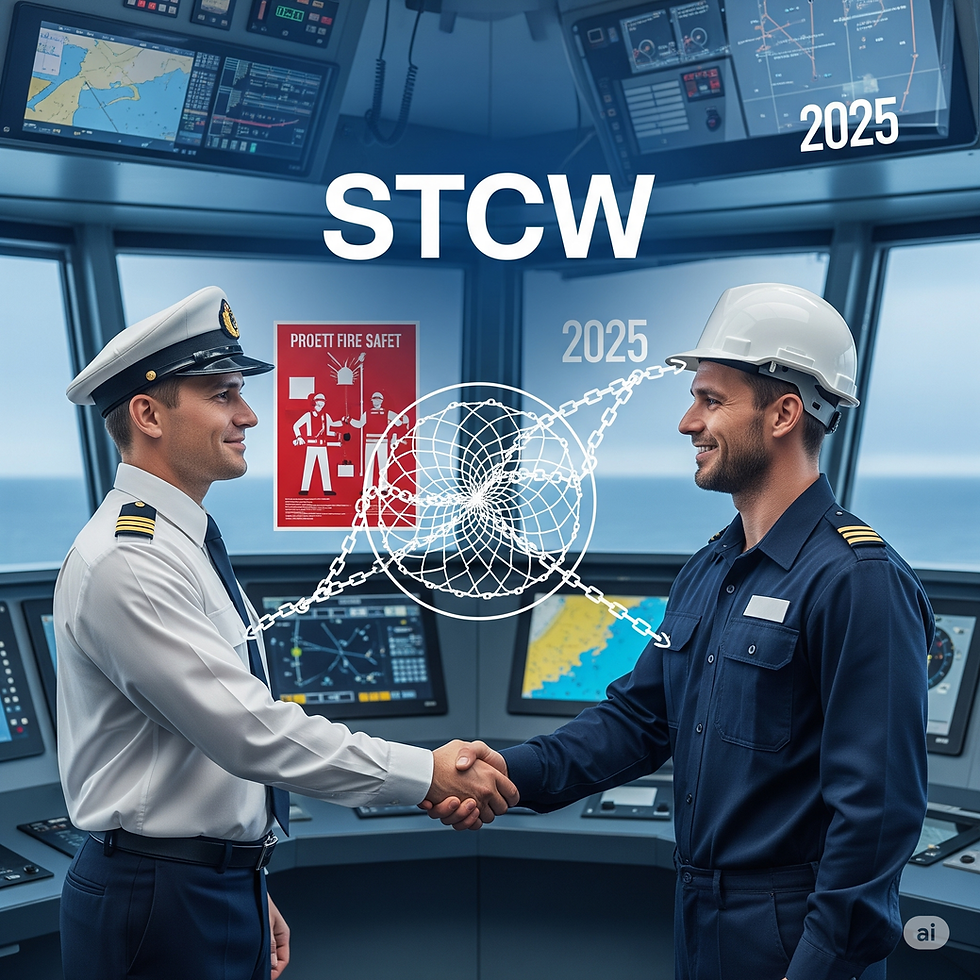🛳️ Watchkeeping Duties and Responsibilities: Deck & Engine Room Standards Explained (2025 Guide)
- kousik pattanayak

- Jul 2
- 7 min read
Updated: Aug 4
🌊 Introduction: Why Watchkeeping is the Heartbeat of Maritime Safety
In the vast, unpredictable expanse of the ocean, every ship, regardless of its size or purpose, relies on one fundamental practice for its safety and efficiency: watchkeeping. It's more than just a duty; it's a continuous vigil, a non-stop commitment that ensures everything onboard operates smoothly, securely, and is ready for any challenge the sea throws its way.
Whether you're standing watch on the bridge, guiding the vessel through intricate waterways, or monitoring the pulse of the ship's machinery in the engine room, proper marine watchkeeping is the backbone of the entire maritime operation. Without vigilant watchkeepers, the risks of collisions, machinery breakdown, and other emergencies skyrocket.
This comprehensive guide, updated for 2025, will dive deep into the essential watchkeeping duties, responsibilities, and the crucial international standards that govern them. We'll break down the complexities of both deck watchkeeping and engine room watchkeeping, explaining them in simple terms for aspiring seafarers, seasoned professionals looking for a refresh, and anyone curious about the intricate world of ship operations. Join us on Ocean Journey Vlog as we explore why watchkeeping matters at sea.

🧭 Understanding Watchkeeping: More Than Just "Looking Out"
At its core, watchkeeping is the practice of maintaining a continuous, alert presence onboard a vessel to ensure its safe navigation, efficient machinery operation, and overall security. This critical function is broadly categorized into two primary areas, each with its unique demands and responsibilities:
Deck Watchkeeping (or Bridge Watch): Focuses on the navigation, steering, and overall safety of the ship's movement.
Engine Room Watchkeeping: Concentrates on the operational health and efficiency of the ship's propulsion and auxiliary machinery.
These vital duties are not just arbitrary ship routines; they are meticulously structured and enforced by the STCW Convention (Standards of Training, Certification, and Watchkeeping for Seafarers). The STCW Code sets the global benchmark, ensuring that every seafarer involved in watchkeeping possesses the necessary skills, knowledge, and discipline to perform their role effectively.

⚓ Deck Watchkeeping Duties & Responsibilities: Navigating with Vigilance
Deck watchkeepers are the eyes and ears of the vessel, directly responsible for the safe navigation and security of the ship. Their station is the bridge, the command center of the vessel. Performing bridge watchkeeping duties effectively is paramount to preventing accidents and ensuring a smooth voyage.
✅ Key Responsibilities of a Deck Watchkeeper:
Maintaining a Proper Lookout: This isn't just about looking out the window. It involves continuous vigilance using all available means – sight, hearing, and electronic aids like radar, AIS (Automatic Identification System), and ECDIS (Electronic Chart Display and Information System). The lookout must detect any potential hazards, including other vessels, land, navigational marks, and dangers.
Monitoring Navigational Equipment: Constantly checking and interpreting data from vital equipment like GPS, radar, ECDIS, auto-pilot, and depth sounders. Any malfunction or unusual reading must be reported immediately to the Officer of the Watch (OOW).
Accurate Logbook Entries: Meticulously recording all relevant events, positions, course changes, weather conditions, machinery status, and communication in the official bridge logbook. This log is a legal document and provides a comprehensive record of the voyage.
Reporting Abnormalities: Promptly informing the OOW of any unusual observations, alarms, or changes in the ship's environment or operational status.
Collision Avoidance: Actively participating in collision avoidance by understanding and applying COLREGs (International Regulations for Preventing Collisions at Sea). This involves assessing collision risks, taking timely and effective action, and communicating intentions to other vessels.
Monitoring Weather Conditions: Keeping a close eye on weather forecasts, sea state, and any changes that could affect the ship's safety or schedule.
Compliance with Regulations: Ensuring that the ship operates in full compliance with all international and local maritime laws and regulations, especially COLREGs.
🕒 Typical Watch Schedule for Deck:
Most ships operate on a structured 4-on/8-off watch schedule. This means a seafarer works for 4 hours and then has 8 hours off. Common watch periods include:
0000 (midnight) – 0400 hrs
0400 – 0800 hrs
0800 – 1200 hrs
And so on, repeating throughout the 24-hour cycle.
Each watch is typically manned by an Officer of the Watch (OOW), who is a certified navigating officer, and a lookout (usually an Able Seaman or Ordinary Seaman).
🛑 Critical Do’s and Don’ts for Deck Watchkeeping:
Do’s | Don’ts |
Stay Alert & Focused at all times. | Use Mobile Phones for personal use on watch. |
Follow Standing Orders from the Master. | Sleep on Watch or show signs of fatigue. |
Communicate Clearly with the OOW and other vessels. | Ignore Alarms or fail to acknowledge them promptly. |
Log All Events accurately and promptly. | Leave the Bridge Unattended or without proper relief. |
Verify Information from multiple sources (e.g., radar vs. visual). | Assume Anything about other vessels' intentions. |

⚙️ Engine Room Watchkeeping Duties & Responsibilities: The Heartbeat of the Ship
While deck watchkeepers handle navigation, engine room watchkeepers are the guardians of the ship's power and auxiliary systems. Their core responsibility is to ensure the safe and efficient operation of all machinery onboard, from the main engine to generators, pumps, and purification systems.
✅ Key Responsibilities of an Engine Room Watchkeeper:
Monitoring Engine Parameters: Continuously checking critical parameters like temperatures (main engine, auxiliaries, cooling water), pressures (fuel, lube oil, cooling), RPM, and fluid levels. Any deviation from normal operating ranges must be investigated.
Checking Systems: Regularly inspecting fuel, lube oil, cooling water, and bilge systems for leaks, unusual noises, or malfunctions. This often involves manual checks and visual inspections.
Logging Hourly Readings: Accurately recording all machinery readings, fuel consumption, and operational events in the engine room logbook at prescribed intervals.
Responding to Alarms & Troubleshooting: Immediately responding to and investigating any alarms, taking corrective actions, and troubleshooting minor issues. Critical alarms must be reported to the duty engineer or Chief Engineer.
Maintaining Cleanliness & Safety: Ensuring a clean, organized, and safe working environment in the engine room, reducing the risk of accidents and fires.
Assisting with Maintenance & Repairs: Assisting senior engineers with routine maintenance tasks, minor repairs, and preparing machinery for overhaul.
🧑🔧 Watchkeeping in UMS (Unattended Machinery Space) Ships:
Modern ships often feature Unattended Machinery Space (UMS) systems, meaning the engine room can operate without a continuous physical presence. In such cases, watch engineers perform periodic rounds (e.g., every 4 hours) to check machinery manually. However, they remain on-call 24/7 via an alarm system (the "Dead Man's Alarm" or "Engineers' Call" system) and must be ready to respond to any emergency or alarm immediately. Their vigilance relies heavily on automated monitoring systems.
🛑 Critical Do’s and Don’ts for Engine Room Watchkeeping:
Do’s | Don’ts |
Wear Appropriate PPE (helmet, safety glasses, gloves, safety boots, ear protection). | Ignore Oil Leaks or any signs of malfunction. |
Follow Checklists for routine checks and start-up/shutdown procedures. | Bypass Safety Systems or override alarms. |
Report Abnormalities to the senior engineer immediately. | Delay Alarm Response – every second counts. |
Keep Tools Organized and machinery spaces tidy. | Leave Machinery Running Unattended without proper monitoring (unless UMS). |

📜 STCW Watchkeeping Standards: The Global Benchmark
The STCW Code, particularly Section A-VIII/2, lays down the minimum international standards for watchkeeping arrangements and principles to be observed. These standards are crucial for promoting maritime safety and preventing pollution. Key aspects include:
Fitness for Duty: Watchkeepers must be physically and mentally fit, free from the effects of alcohol or fatigue. Adequate rest periods are mandatory.
Proper Handover: A thorough and clear handover of duties between watches is essential. This includes conveying all relevant information about the ship's status, conditions, and any ongoing operations or potential hazards.
Situational Awareness: All watchkeepers must maintain a high level of situational awareness, understanding the ship's position, surrounding traffic, prevailing weather conditions, and any special circumstances.
Emergency Readiness: Watchkeepers must be fully aware of all emergency procedures, alarm systems, escape routes, and fire-fighting equipment locations. They must be prepared to act swiftly in any emergency.
All individuals performing watchkeeping duties must be appropriately certified and trained under these stringent STCW guidelines, ensuring a global standard of competence for seafarers.
🧠 Tips for Effective Watchkeeping: Mastering the Art of Vigilance
Being a successful watchkeeper requires more than just technical knowledge; it demands discipline, focus, and continuous learning. Here are some invaluable tips for both deck and engine room watchkeepers:
✅ Prioritize Rest & Hydration: Adequate sleep and staying hydrated are fundamental to maintaining alertness and focus during long watches.
✅ Utilize Checklists: Always use and create checklists for routine tasks, emergency procedures, and equipment checks. They ensure consistency and prevent omissions.
✅ Foster Clear Communication: Effective communication with the OOW, fellow watchkeepers, other departments, and shore authorities is vital. "Clarity is key."
✅ Embrace Continuous Learning: Maritime technology and regulations evolve. Stay updated with new equipment, procedures, and safety protocols.
✅ Report Everything: Even seemingly minor issues should be reported. Early detection and prevention are far better than reactive damage control.
✅ Maintain Discipline: Stick to the watch schedule, avoid distractions, and perform duties diligently.
🧭 Conclusion: Watchkeeping – The Lifeline Connecting Ship and Safety
Ultimately, whether you're meticulously steering the vessel from the bridge or ensuring the optimal performance of every mechanical part in the engine room, watchkeeping is a sacred and non-negotiable duty. It is the continuous, vigilant lifeline that connects the ship to safety, efficiency, and environmental protection.
By diligently following international STCW standards, staying alert, and upholding the highest levels of professionalism, every watchkeeper becomes an indispensable part of the ship's very heartbeat. Your commitment ensures the safety of the crew, the integrity of the cargo, and the protection of our precious marine environment.
If you found this comprehensive guide helpful for your maritime career or simply gained a better understanding of ship safety, don't forget to share it with fellow seafarers and maritime enthusiasts, leave a comment with your insights or questions, and most importantly, subscribe to Ocean Journey Vlog for more essential seafarer-friendly content, guides, and vlogs!



Comments